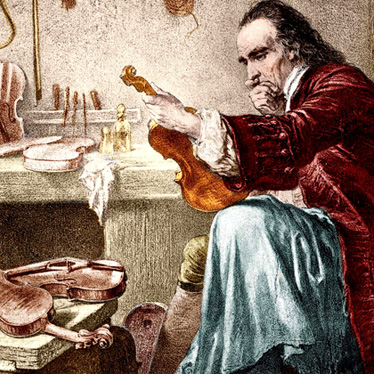Spotlight on Historic Violin Maker Antonio Stradivari (1644-1737)

Italian instrument maker, Antonio Stradivari, has long been regarded as one of the finest instrument makers of all time. Primarily a builder of violins, violas, and cellos, his career started around 350 years ago. Today, many instruments he made with his own hands are still in use. His instruments command the highest prices at auctions and have been owned and played by some of the world’s top musicians of every generation for the past 300-plus years.
Stradivari’s name is well-known by musicians and non-musicians alike. His patterns have been copied hundreds of thousands of times by makers and manufacturers of string instruments. Countless student violins have been inscribed and labeled with the name Stradivarius to entice possible buyers. (Stradivarius, the Latin form of the name, is often used when discussing Stradivari’s instruments or copies).
Early life
Very little is known about the early life of Antonio Stradivari, including his exact birthdate and the city of his birth. It is surmised that he was born in 1644 in Cremona, Italy, to Alessandro Stradivari. Cremona was a city that had been known for its master violin makers for nearly 100 years. It is thought that Stradivari apprenticed with Cremona’s leading violin maker, Nicolo Amati, who was the 3rd generation of violin makers in his family. Stradivari is thought to have apprenticed with Amati starting in the late 1650s.
There is another theory, in which Stradivari actually started out as a woodcarver and inlayer employed by Amati. This theory is supported by his elaborate purfling work and decorations on some of his later violins.
Around 1680, Stradivari began to develop his own style and model for the violin family of instruments. He moved to No. 1 Piazza Roma, just down the street from several other top violin making families of Cremona (including the Amatis and Guarneris), and lived there for the rest of his life.
Golden period
Stradivari’s work was marked by experimentation, and in the early 1690s he changed several elements in his instruments. He developed a pattern for a violin that was larger, referred to as “long Strads,” and started using a redder, darker varnish, different from the yellower varnish he had been using (similar to Amati’s). In 1698 he abandoned the larger model violin, and from 1700-1720 settled into one of his finest periods of work called the “Golden Period” by later historians.
Not just violins
Although Stradivari is most famous for his violins, he also crafted cellos, violas, harps, guitars, and even mandolins. It is estimated that he made over 1,100 instruments in his life. About 650 instruments still survive, including between 450-512 violins.
Here is Krishnasol Jiménez playing Bartolotti's Passacaglie on an Antonio Stradivari "Sabionari" guitar from 1679:
Mysteries of Stradivari
One of the enduring mysteries of Stradivarius violins is the varnish. Stradivari’s legendary varnish has puzzled and fascinated violinmakers, historians, musicians, and even chemists since the beginning of the 19th century. Stradivari’s patterns for the actual violin had long been exhaustively analyzed and the wood and other elements scrutinized to discover the secrets of the fine qualities of the sounds produced by his instruments. The qualities of his varnish have turned out to be an elusive “secret” and one of the mysteries surrounding the instruments of Stradivari.
What’s in a name?
Every Stradivarius instrument has been given a name. Some bear the name of a previous owner or famous player of the instrument (“Le Sarasate" after the great violin virtuoso Pablo de Sarasate, “Leonardo da Vinci”– owned by the Da Vinci family), composers (the “Wieniawski”),and some have more romantic names like the “Sleeping Beauty.”
Napoleon was once thought to have owned the “Molitar” Stradivarius violin. Yo Yo Ma owns probably the most famous cello in existence: the “Davidov” Stradivarius, once owned by Jacqueline du Pre.
Here is Yo Yo Ma playing his famous “Davidov” Strad:
Late career
Stradivari continued working into his nineties – if we count 1644 as his birth date. It is thought that even though Stradivari had a very long working career, it may have been impossible for him to have made more than 1000 instruments entirely by himself, so it has been argued that his sons Francesco and Omobono – and maybe a third son – were working in the family shop and contributed to the large output.
The enduring legacy
Antonio Stradivari created a standard to which many – and even most – instruments are compared to, even 300 years later. His legacy to the violin family of instruments includes lending to the inspiration of countless instrumentalists and instrument makers to create the most beautiful sounds possible from their instruments – a life that transcends wood, varnish, and time.
Top image: Antonio Stradivari examining an instrument, courtesy of Wikicommons


